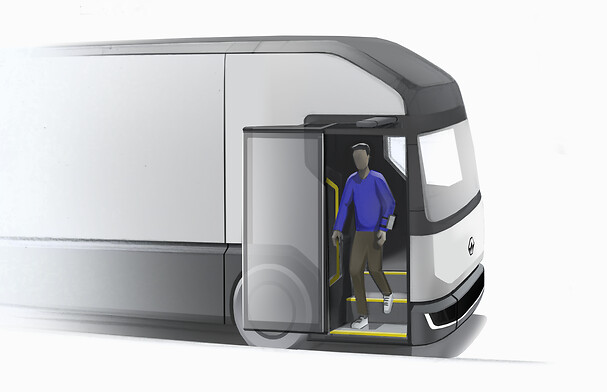Renault Trucks and GEODIS join forces to develop a new electric truck adapted to urban logistics

Renault Trucks and GEODIS are combining their industrial, logistics and engineering expertise to design an electric heavy truck dedicated to urban logistics, meeting the requirements of city-center freight transport.
Renault Trucks and GEODIS are combining their industrial, logistics and engineering expertise to design an electric heavy truck dedicated to urban logistics, meeting the requirements of city-center freight transport.
Changes are occurring in urban freight transport, whether in terms of emission regulations, restricted access, or the proliferation of modes of mobility (cargo bikes, bicycles, scooters, etc.) sharing the public space.
For reasons of massification1 , vehicles with a tonnage of over 3.5 tonnes will remain at the core of urban distribution. With a complete range of electric vehicles manufactured in France ranging from 3.5 to 26 tonnes, Renault Trucks has been working for ten years on reducing the environmental footprint of city logistics. GEODIS, whose ambition is to reduce its CO2 emissions by 30% by 2030, has undertaken to
provide carbon-free deliveries to 37 cities in France by 2023.

Through their new collaboration, the constructor and its logistics partner are taking this approach a step further and combining their know-how to develop a brand new 16-tonne electric urban truck, at a comparable cost (TCO2) to that of a diesel vehicle, which is a prerequisite for the widespread adoption of alternative power units.
Marie-Christine Lombard, Chief Executive Officer of GEODIS, said: “The environmental emergency combined with the growth of e-Commerce and the implementation of low-emission zones in major French cities mean that we urgently need to step up the decarbonization of transport. This is the objective of GEODIS in forming this partnership with Renault Trucks. Wewant to quickly provide concrete answers to the issue of sustainable urban logistics.”
Bruno Blin, president of Renault Trucks, added: “We have noticed that the image of the truck is changing; at last it is being perceived as an indispensable tool. The purpose of the Oxygen project, in which Renault Trucks is working alongside GEODIS, is to design a truck that will seamlessly blend into the urban landscape, among other road users in areas with traffic and even in pedestrian zones. This new truck will be designed for the driver’s working comfort and safety, and for the safety of city dwellers.”
Through their new collaboration, the constructor and its logistics partner are taking this approach a step further and combining their know-how to develop a brand new 16-tonne electric urban truck, at a comparable cost (TCO2) to that of a diesel vehicle, which is a prerequisite for the widespread adoption of alternative power units.

Marie-Christine Lombard, Chief Executive Officer of GEODIS, said: “The environmental emergency combined with the growth of e-Commerce and the implementation of low-emission zones in major French cities mean that we urgently need to step up the decarbonization of transport. This is the objective of GEODIS in forming this partnership with Renault Trucks. We want to quickly provide concrete answers to the issue of sustainable urban logistics.”
Bruno Blin, president of Renault Trucks, added: “We have noticed that the image of the truck is changing; at last it is being perceived as an indispensable tool. The purpose of the Oxygen project, in which Renault Trucks is working alongside GEODIS, is to design a truck that will seamlessly blend into the urban landscape, among other road users in areas with traffic and even in pedestrian zones. This new truck will be designed for the driver’s working comfort and safety, and for the safety of city dwellers.”
A truck that seamlessly blends into the urban landscape
Thanks to the collaborative work carried out from the design stage onwards, this vehicle (project name: Oxygen) will make it possible to integrate all the requirements and functions of citycenter delivery: elimination of nuisances such as pollution and noise, and improvement of active and passive safety in order to better manage co-existence with all road users (pedestrians and people using soft modes of transport).
In the early phases of work, the following areas of focus were identified:
Improved safety for the driver and the public thanks to a lowered cab giving the driver an excellent direct view for optimal protection of road users; a large windshield and multiple cameras instead of rear-view mirrors, offering a 360° view; a sliding side door on the passenger side restricting the door opening angle.
Greater comfort for the driver, who will be able to get out of the truck on either side, left or right. Climbing in and out of the truck will be made easier by a much lower access height than on a standard delivery truck.
Optimal ergonomics and easier access to the cargo space. To achieve this, a three-way partnership with a bodybuilder is under consideration with a view to improving loading/unloading operations in an urban environment.
Connected tools enabling drivers to optimize their delivery operations and their routes.
To ensure that this vehicle blends into the urban landscape perfectly and with a view to enhancing both the comfort and the self-esteem of the driver, Renault Trucks designers have completely redesigned both the exterior lines of the truck and the interior of the cab.
Delivery of the prototype is scheduled for the end of 2022. It will be produced at Renault Trucks’ site in Blainville-sur-Orne, France, the first European plant to manufacture series production electric trucks since 2020.

1 One 12-tonne truck is equivalent to more than 3 LCVs (light commercial vehicles).
2 TCO = Total Cost of Ownership, i.e. the overall cost of an asset or a service throughout its life cycle





